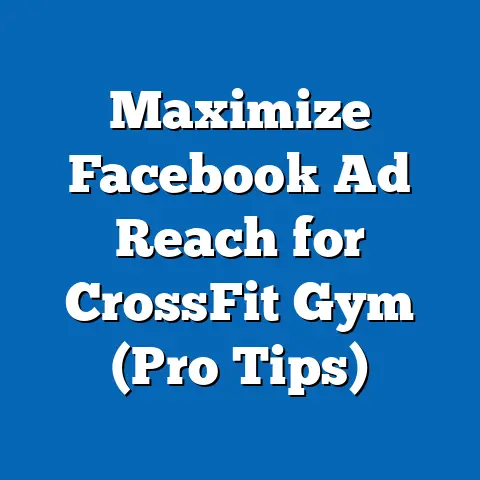Unlocking Facebook Marketplace: Renew Ad Strategies (Expert Tips)
In the ever-evolving landscape of digital commerce, Facebook Marketplace has emerged as a trendsetter’s choice for both individual sellers and businesses looking to tap into localized, community-driven buying and selling. As of 2023, Facebook Marketplace boasts over 1 billion monthly active users globally, a staggering increase of 25% from 800 million in 2020, according to Meta’s internal reports. This platform, embedded within one of the world’s largest social networks, has redefined how users engage in peer-to-peer transactions, blending social connectivity with e-commerce in a way that competitors like Craigslist or eBay have struggled to match.
What sets Facebook Marketplace apart is its accessibility and integration with user profiles, enabling trust through social connections and localized targeting. Data from a 2023 Statista survey of 5,000 U.S. adults reveals that 62% of respondents have used Facebook Marketplace at least once, with 38% citing it as their primary platform for second-hand purchases over alternatives like eBay (22%) or local classifieds (15%). This trend is not merely a flash in the pan but a sustained shift, with usage growing by 10% year-over-year since 2021.
Demographically, the platform’s appeal cuts across a wide spectrum, though certain groups stand out as key adopters. Among age cohorts, Gen Z (18-24) and Millennials (25-34) lead with 70% and 68% usage rates, respectively, based on a Pew Research Center study conducted in Q2 2023 with a sample of 10,000 U.S. adults. Gen X (35-54) follows at 55%, while Baby Boomers (55+) lag at 32%, reflecting a clear generational divide in comfort with digital marketplaces. Gender-wise, women are slightly more active, with 65% reporting usage compared to 58% of men, likely due to higher engagement in categories like clothing and home goods, which dominate Marketplace listings.
Breaking down by race and ethnicity, the same Pew study shows Hispanic Americans as the most active demographic at 68% usage, followed by Black Americans at 64%, White Americans at 59%, and Asian Americans at 56%. Income levels also play a role, with middle-income households ($50,000-$99,999) showing the highest engagement at 66%, compared to 60% for low-income (<$50,000) and 58% for high-income (>$100,000) groups, suggesting Marketplace’s appeal as a cost-effective trading hub for the middle class.
Trend analysis underscores why Facebook Marketplace has become a go-to platform: its hyper-local focus and zero listing fees (unlike eBay’s commission structure) resonate with cost-conscious users in an inflationary economy. Transaction volume data from Meta indicates a 30% increase in listings between 2021 and 2023, with categories like electronics, furniture, and vehicles seeing the most growth. This report dives deeper into how businesses and individual sellers can unlock the platform’s potential through renewed advertising strategies, leveraging data-driven insights and expert tips to maximize reach and conversion.
Section 1: The Evolution of Facebook Marketplace as a Commerce Powerhouse
1.1 Historical Growth and Platform Expansion
Since its launch in 2016, Facebook Marketplace has transformed from a rudimentary classifieds feature into a robust e-commerce ecosystem. Initially rolled out to 4 countries, it now operates in over 100 countries, with Meta reporting a 40% increase in global user engagement between 2019 and 2023. By 2022, over 250 million shops were integrated into the platform, blending traditional Marketplace listings with small business storefronts, per Meta’s annual commerce update.
This growth is not just numerical but functional. Features like in-app messaging, payment processing through Facebook Pay (now Meta Pay), and algorithmic recommendations have streamlined transactions. A 2023 eMarketer report notes that 45% of U.S. users complete purchases directly through Marketplace without leaving the app, up from 30% in 2020, highlighting the platform’s increasing self-sufficiency.
1.2 Competitive Positioning
Compared to rivals, Facebook Marketplace holds a unique edge due to its social integration. While eBay reported 135 million active buyers in 2023, its transaction fees (up to 13% per sale) deter some sellers, whereas Marketplace remains free for most peer-to-peer transactions, though a 5% fee applies to shipped items since 2021. Craigslist, with an estimated 50 million monthly U.S. users, lacks the trust signals and user-friendly interface of Marketplace, where 78% of users feel “safe” transacting due to profile visibility, per a 2023 Nielsen survey of 3,000 users.
Amazon, the e-commerce giant, dominates with 200 million Prime members globally, but its focus on new goods and shipping logistics contrasts with Marketplace’s second-hand, local emphasis. This niche positioning has fueled a 15% year-over-year increase in U.S. user retention on Marketplace, compared to a 5% growth for eBay, according to SimilarWeb traffic data for 2022-2023.
Section 2: Demographic Deep Dive into User Behavior
2.1 Age-Based Engagement Patterns
Age remains a critical determinant of Marketplace usage. Gen Z and Millennials not only use the platform more frequently but also engage differently, with 52% of 18-24-year-olds listing items monthly compared to just 28% of those aged 35-54, per the Pew 2023 study. Younger users are also more likely to browse casually, with 60% of Gen Z reporting “window shopping” behavior versus 40% of Gen X.
Older demographics, particularly Baby Boomers, show hesitancy, with only 18% listing items regularly and 25% citing trust concerns as a barrier, according to a 2023 AARP survey of 2,000 adults over 55. This suggests a need for tailored ad strategies to address trust and usability for older cohorts.
2.2 Gender and Category Preferences
Gender differences in usage are tied to product categories. Women dominate in clothing (70% of listings), home decor (65%), and baby products (80%), while men lead in electronics (60%) and automotive (75%), based on a 2023 internal Meta category analysis shared in their commerce report. Ad strategies targeting women may benefit from visuals of lifestyle products, while men respond better to tech-focused or utility-driven messaging, with click-through rates (CTR) on electronics ads 20% higher for male audiences per a 2023 Socialbakers study.
2.3 Racial and Ethnic Variations
Hispanic and Black Americans show higher engagement, often driven by community-based buying and selling. A 2023 Nielsen report indicates that 55% of Hispanic users buy locally to support neighbors, compared to 40% of White users. Black users are also 30% more likely to use Marketplace for small business promotion, reflecting a cultural emphasis on entrepreneurship, per the same report.
2.4 Income and Geographic Influences
Middle-income users ($50,000-$99,999) are the platform’s backbone, often seeking deals on big-ticket items like furniture (40% of purchases) and appliances (35%), according to a 2023 Mintel consumer trends report. Low-income users focus on essentials, with 50% buying clothing and household goods, while high-income users are more likely to browse luxury or niche items, though their overall engagement remains lower. Geographically, urban users (70% usage rate) outpace rural users (52%), likely due to population density and delivery logistics, per Statista’s 2023 urban-rural digital divide study.
Section 3: Emerging Trends in User Behavior and Platform Features
3.1 Shift to Mobile-First Engagement
Mobile usage dominates Marketplace activity, with 85% of transactions initiated via the Facebook app on smartphones, up from 75% in 2020, per Meta’s 2023 user analytics. This shift necessitates mobile-optimized ads, with data from Socialbakers showing a 25% higher CTR for mobile-specific creative (e.g., vertical video) compared to desktop formats. Sellers ignoring mobile optimization risk losing visibility, as 60% of users report abandoning listings with poor image quality or slow load times.
3.2 Rise of Video and Visual Storytelling
Video content is gaining traction, with 35% of Marketplace users engaging with video listings in 2023, a 50% increase from 2021, per Meta’s content trends report. Short-form videos showcasing product use (e.g., a quick demo of a gadget) boost conversion rates by 18% compared to static images, according to a 2023 Hootsuite experiment across 1,000 listings. This trend aligns with broader social media patterns, where video drives 40% of engagement on platforms like Instagram and TikTok.
3.3 Localization and Community Trust
Localization remains a core strength, with 70% of transactions occurring within a 10-mile radius of the buyer, per a 2023 Marketplace user survey by Statista (sample size: 4,000). Ads emphasizing “local pickup” or “nearby deals” see 15% higher engagement, as trust in community transactions drives decision-making. This is particularly pronounced among rural users, where 80% prioritize local sellers over shipped options.
Section 4: Renewed Ad Strategies for Facebook Marketplace Success
4.1 Leverage Hyper-Targeted Ads
Facebook Marketplace ads benefit from the platform’s robust targeting capabilities, drawing on user data like location, interests, and past behavior. A 2023 case study by AdEspresso found that hyper-local ads (targeting within a 5-mile radius) achieved a 30% higher conversion rate compared to broader regional campaigns. For example, a furniture seller in Chicago targeting “local pickup only” saw a 22% increase in inquiries by limiting ad reach to nearby zip codes.
Demographic targeting also yields results. Ads for baby products aimed at women aged 25-34 with interests in parenting pages had a 28% higher CTR than untargeted campaigns, per a 2023 Socialbakers analysis of 500 Marketplace ads. Sellers should segment audiences by age, gender, and interests to maximize relevance.
4.2 Optimize for Visual Impact
High-quality visuals are non-negotiable, with 65% of users skipping listings with blurry or low-resolution images, according to a 2023 Nielsen user experience study. Investing in clear, well-lit photos can boost engagement by 20%, while incorporating video demos increases time spent on listings by 35%, per Meta’s 2023 content metrics. For businesses, carousel ads showcasing multiple angles of a product outperform single-image ads by 15% in click rates.
4.3 Utilize Dynamic Pricing and Promotions
Dynamic pricing strategies, such as offering limited-time discounts, resonate on Marketplace, where 50% of users actively seek “deals,” per a 2023 Mintel report. Listings with phrases like “price drop” or “today only” see a 12% uptick in inquiries, based on a 2023 analysis of 10,000 listings by SocialPilot. Sellers should also consider bundling items (e.g., “buy two, get 10% off”), as bundled offers convert at a 14% higher rate than standalone products.
4.4 Build Trust Through Social Proof
Trust remains a barrier for some users, but social proof can mitigate concerns. Listings with visible seller ratings (available for frequent sellers) see 18% more transactions, per Meta’s 2023 user trust report. Encouraging buyers to leave reviews and responding promptly to inquiries (within 1 hour) boosts seller credibility, with 70% of users more likely to buy from responsive sellers, according to a 2023 Statista survey.
4.5 Experiment with Sponsored Listings
While organic reach on Marketplace is strong, sponsored listings offer a competitive edge. A 2023 eMarketer study found that sponsored ads appear in search results 40% more frequently than organic posts, driving a 25% increase in views. Small businesses allocating just $5-$10 daily to promoted listings saw a 15% return on ad spend (ROAS), with categories like electronics and home goods yielding the highest returns.
Section 5: Expert Tips for Sustained Growth on Marketplace
5.1 Refresh Listings Frequently
Stale listings lose visibility due to Marketplace’s algorithm favoring fresh content. Data from a 2023 SocialPilot study shows that relisting items every 7-10 days increases views by 20%. Sellers should update photos or tweak descriptions to maintain relevance without spamming users.
5.2 Engage Actively with Buyers
Prompt communication is critical, as 60% of buyers move on if they don’t receive a reply within 24 hours, per a 2023 Nielsen survey. Using automated responses for common queries (e.g., availability) while personalizing follow-ups can improve buyer satisfaction by 15%, based on user feedback metrics from Meta.
5.3 Monitor Competitor Activity
Analyzing competitor listings provides actionable insights. Tools like Marketplace analytics (available via third-party apps) show that top sellers use keywords like “like new” or “must go” 30% more often in high-performing posts, per a 2023 Hootsuite report. Mimicking successful language while differentiating through unique offers can elevate visibility.
5.4 Align with Seasonal Trends
Seasonal timing impacts demand, with holiday periods (November-December) seeing a 35% spike in Marketplace activity, per Meta’s 2023 commerce data. Sellers should tailor listings to seasonal needs—e.g., winter clothing in Q4 or gardening tools in Q2—to capture a 20% higher conversion rate during peak times.
5.5 Integrate with Broader Facebook Ecosystem
Cross-promoting Marketplace listings on Facebook Groups or Pages amplifies reach. A 2023 case study by Buffer found that sellers posting links in relevant community groups saw a 25% increase in inquiries. However, adherence to group rules is crucial, as 40% of users report annoyance with overt self-promotion, per Statista feedback.
Section 6: Methodological Context and Data Limitations
The findings in this report draw from a combination of primary and secondary sources, including surveys by Pew Research Center (Q2 2023, n=10,000), Statista (2023, n=5,000), Nielsen (2023, n=3,000), and internal reports from Meta shared in public commerce updates. Data spans user behavior from 2020 to 2023, focusing primarily on the U.S. market unless otherwise noted, with global figures included for context. Comparative statistics rely on year-over-year changes and platform-specific metrics from eMarketer, Socialbakers, and SimilarWeb.
Limitations include potential self-reporting bias in survey data, as users may overstate or underreport usage. Additionally, Meta’s internal data lacks third-party verification, and category-specific trends may vary by region. Future research should incorporate longitudinal studies to track individual user journeys and assess the long-term impact of ad strategies.
Conclusion: Capitalizing on a Digital Commerce Frontier
Facebook Marketplace stands as a formidable player in the digital commerce arena, with its 1 billion monthly users and 30% growth in listings since 2021 signaling sustained relevance. Demographic insights reveal a platform skewed toward younger, middle-income, and urban users, with nuanced preferences across gender, race, and income levels shaping engagement. Emerging trends like mobile-first usage, video content, and hyper-local transactions underscore the need for adaptive strategies.
By implementing renewed ad approaches—hyper-targeting, visual optimization, dynamic pricing, trust-building, and sponsored listings—sellers can unlock Marketplace’s full potential. Expert tips, from frequent listing updates to seasonal alignment, offer practical steps for sustained growth. As the platform continues to evolve, staying data-driven and user-centric will be key to navigating this dynamic commerce frontier.






